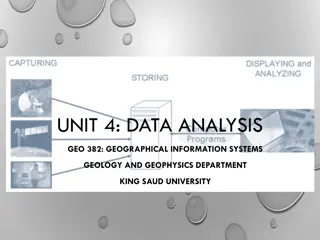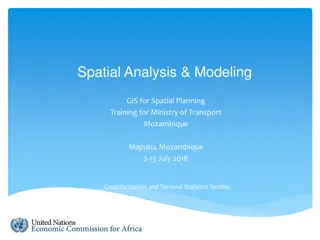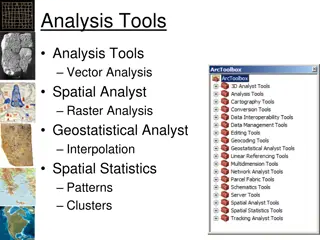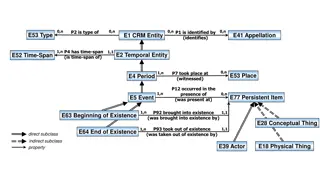Understanding Spatial Referencing Systems for Mapping
Spatial reference systems play a crucial role in defining geographic parameters and coordinate systems for mapping. They consist of components like orientation, latitude, longitude, and elevation, which help in representing spatial properties on maps. Reference surfaces such as the Geoid and ellipsoid are used to approximate the Earth's shape, with geodetic datums serving as anchor points on the ellipsoid. Learn about the point of origin, equatorial and polar radii, and prime meridian in spatial reference systems.
Download Presentation

Please find below an Image/Link to download the presentation.
The content on the website is provided AS IS for your information and personal use only. It may not be sold, licensed, or shared on other websites without obtaining consent from the author. Download presentation by click this link. If you encounter any issues during the download, it is possible that the publisher has removed the file from their server.
E N D
Presentation Transcript
Unit 3 Spatial referencing TYIT SEM VI
Spatial Reference System Spatial Reference System Spatial reference systems (SRS) consist of components that describe a series of geographic parameters, such as the orientation, latitude, longitude, and elevation in reference to geographic objects, which define coordinate systems and spatial properties on a map.
Reference surfaces for mapping Reference surfaces for mapping The surface of the Earth is not uniform. The oceans can be treated as reasonably uniform, but the surface or topography of the land masses exhibits large vertical variations between mountains and valleys. These variations make it impossible to approximate the shape of the Earth with any reasonably simple mathematical model. Consequently, two main reference surfaces have been established to approximate the shape of the Earth. One reference surface is called the Geoid, the other reference surface is the ellipsoid.
Reference surfaces for mapping Reference surfaces for mapping The underlying assumption of spatial reference systems is that the Earth is a geoid. Since it would be difficult to precisely calculate the Earth as a geoid, we use the next best shape, an ellipsoid (or a flattened sphere; also known as a spheroid). A spatial reference point or anchor point is selected on the ellipsoid for a frame of reference. We call this point a geodetic datum.
Spatial Reference System Spatial Reference System The point of origin on a map is an easy way to visualize geodetic datum (Point P). It indicates the center and orientation of the ellipsoid. It includes a description of the position and orientation of the ellipsoid. It is made up of an equatorial radius (semi-major axis) and a polar radius (semi-minor axis) (the dotted lines running from N to the equator on image above). These lines are then calculated, producing a flattening measurement that measures the compression relative to the equatorial axis, providing the shape of the ellipsoid. The datum also has a prime meridian that is set to zero longitude (the solid line running from N to the equator). This is usually set to the Greenwich prime meridian; however, it might differ if using an older, or localized datum for a particular area or region. Don't worry about calculating geodetic datum, unless you need to create your own. Most of the datum that you will use are predefined, so it isn't necessary to get out your calculator and compass to create your own.
Spatial Reference System Spatial Reference System Now that we have a datum, we can use a geographical coordinate reference system (or geodetic coordinate system) to provide longitude and latitude coordinates on the ellipsoid. It's important to note that longitude and latitude coordinates depend on the datum used, but their values are not unique to to any particular datum. It is important to note that if you do not know the datum being used, your coordinate system could be off by 1 meter to several hundred meters. Therefore, the consequences of not knowing the datum could pose significant problems. The last component of the SRS is a projection. Projection refers to taking the Earth as a 3D ellipsoid and squashing it onto a 2D flat surface. There are many types of projections but they all fall on a Cartesian coordinate system and depend on the geographic coordinate reference system used. Choosing which projection to use depends on several factors such as measurement, shape, direction, and range, and each has its tradeoffs. The most common type of projections are conic, cylindrical, and azimuthal/planar. These are classified into different flavors such as Mercator, Lambert Azimuthal Equal Area, Lambert Conformal Conic, Universal Trans Mercator (UTM), national grid systems, state plane, and geodetic. For a description of these, see here.
A spatial reference system (SRS) is made up of a an ellipsoid, geodetic datum, and a geographic coordinate reference system with an associated projection. Often, when working with SRSs you will find that they are referred to by a number following the acronym EPSG. These are predefined SRSs with unique IDs, which are recognized and used throughout the GIS industry.
EPSG EPSG When working with databases or GIS libraries, you will see the number 4326 referred to a lot. It's full name, EPSG 4326, is a unique SRS identification number developed by the European Petroleum Survey Group, or EPSG. You will also find that EPSG 4326 is referred to as WGS 84. WGS is the World Geodetic System which is a standardized geodetic system developed in 1984. What makes EPSG 4326/WGS 84 well-known is that it is used by the US Department of Defense, NATO, and Global Positioning Systems (GPS). Identification numbers like 4326 refer to a standardized collection of SRSs and coordinate transformations. These numbers have been archived and can be viewed in the Geodetic Parameter Registry. Below is a snapshot of EPSG 4326 from the registry. When we look at 4326, we notice that it comprises two main features: geodetic datum and ellipsoidal coordinate system (or geodetic coordinate system).
geodetic coordinate systems are the latitude and longitude points derived from geodetic datum. Geodetic datum refer to a set of points, or anchors, where survey measurements are based. There are two types of datum: global or local. Some localized datum can be more accurate than datum that cover larger areas since they concentrate on one area. The most recognized datum are WGS 84 (covering the entire world) and NAD 83 (covering only North America). The anchor for WGS 84 is placed at the center of the Earth, while NAD 83 has its anchor placed at the center of North America, lying in the middle of northern Canada. From the registry we can see that although both datum use the same semi-major axis, or radius, they have slightly different flattening calculations. The differences in the calculations are based on the locations where each takes measurements from. NAD 83 uses the North American Plate as a reference, which can change by up to 2 cm per year. WGS 84 does not change, since it takes reference points from all over the Earth.
Geographic coordinate systems Geographic coordinate systems A geographic coordinate system (GCS) uses a ellipsoidal surface to define locations on the Earth. There are three parts to a geographic coordinate system: A datum - an ellipsoidal (spheroid) model of the Earth to use. Common datums include WGS84 (used in GPS) and NAD83 (used in surveying and mapping in North America). A prime meridian Angular unit of measure
Projected coordinate systems Projected coordinate systems Projected coordinate systems define a flat 2D Cartesian surface. Unlike a geographic coordinate system, a projected coordinate system has constant lengths, angles, and areas across the two dimensions. A projected coordinate system is always based on a geographic coordinate system that references a specific datum.
Commonly used coordinate reference systems Commonly used coordinate reference systems 4326 - GPS 4326 is the most common spatial reference for storing a referencing data across the entire world. It serves as the default for both the PostGIS spatial database and the GeoJSON standard. It is also used by default in most web mapping libraries. Because of its use in GPS, 4326 is generally assumed to be the spatial reference when talking about "latitude" or "longitude". 3857 - Web Mercator The Web Mercator coordinate reference system is the default in most web mapping libraries. Web Mercator preserves a consistent direction and north is always "up" on a Web Mercator map. Angles are also depicted accurately, so a 90-degree turn on a Web Mercator map will actually look like a right angle. That said, the projection distorts both shape and size as distance from the equator increases. Web Mercator is ideal for generating map tiles since it will project the world into a square that can be subdivided evenly across zoom levels. For example one tile at zoom level 1, four tiles at zoom level 2 and so on.
























